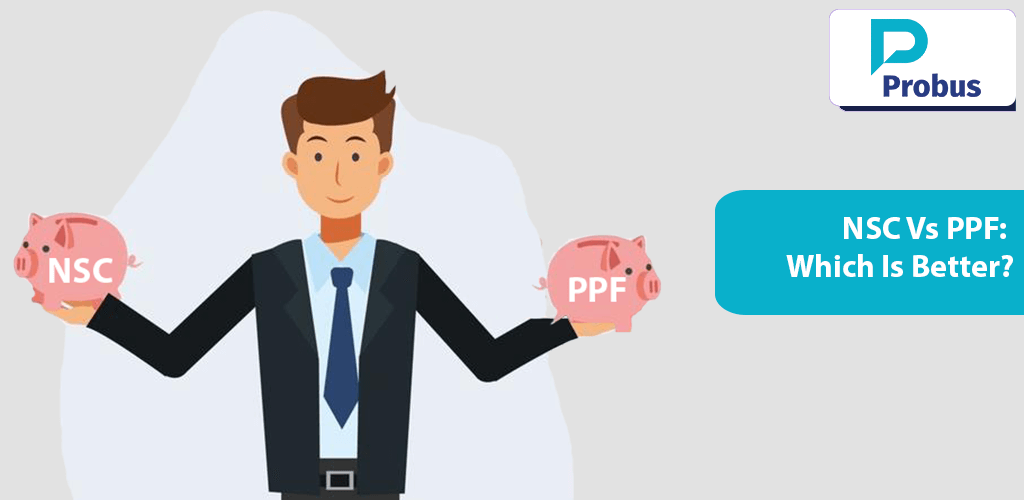If you are looking for a safe and reliable investment option, then PPF and NSC can be your ideal choices. You can choose any of these to cater to your financial targets. Also, both of these are quite beneficial when it comes to returns, tax benefits, and safety. Both PPC and NSC offer guaranteed interest and safeguard your capital. If you are confused as to which option to go with, then this blog will surely come in handy for you. Read on to know the intricacies of NSC and PPF.
What Do You Mean By NSC and PPF?
Let’s understand NSC closely. NSC stands for National Savings Certificate. This savings scheme is offered by the Indian government. The minimum amount of investment is 100 rupees. NSC comes with a tenure of 5 years which is non-expandable. The rate of interest on a national savings certificate is 6.8% at present and it gets compounded annually. NSC is available for Indian residents only.
NSC offers the following benefits:
- NSC is easily accessible from your nearest post office.
- You can get loans against your NSC certificates.
- There is no maximum limit if investment in NSCs.
- NSCs offer assured returns to the investors after the completion of 5 years.
- NSC holders can claim for tax exemption as per Section 80C.
PPF stands for Public Provident Fund. You can consider it as an investment as well as a tax-saving instrument. The lock-in period for a PPF is 15 years. And the minimum amount that you can invest in a PPF is 500 rupees. You can have just one PPF account. And the rate of interest in a PPF is a whopping 7.1%.
PPF offers the following advantages:
- PPF offers tax benefits.
- You can avail of loans against your PPF between the 3rd and the 5th year.
- You can make multiple deposits of INR 50 throughout a financial year.
- Once you have completed 5 years, you can withdraw your PPF partially.
Differences Between PPF and NSC - A Detailed Comparison
| PARAMETERS | NSC | PPF |
| Minimum Amount to be invested | INR 100 | INR 500 |
| Maximum amount to be invested | No capping on the maximum amount | INR 1.5 lakhs |
| Tenure | 5 years | 15 years |
| Rate of interest | 6.8% per annum | 7.1% per annum |
| Maximum number of accounts | You can have unlimited NSCs in your name | 1 PPF account only |
| Contributor | Guardian (in case of a minor), self, joint account holder | Guardian (in case of a minor), self |
| Pattern for account holding | Joint or single holders | One holder allowed only |
| Loan | Allowed to avail loan | Allowed to avail loan between the 3rd and the 5th year |
| Premature withdrawal | It is possible to exit the scheme early (Exception: Death of investor) | It is possible after the completion of 5 years |
| Point of withdrawal | Withdrawals can be made at the post office from where you have bought the NSC | Withdrawal is possible from where you have purchased the PPF. You can also get the FORM C downloaded and then submit it at a nearby office. |
| Tax benefits | The invested amount is tax-free (upto INR 1.5 lakhs). But the interest that you get from NSCs is taxable under the “income from other sources” category | The maturity amount as well as the interest are tax-free. And the contribution amount also does not come under any tax law. |
Concluding Thoughts - Which One Is a Better Choice?
If you wish to play it safe and are scared of the market volatility, both PPF and NSC are safe and guaranteed investment options. You can take the help of a professional financial planner to make seamless investments in either of these two investment instruments. You can already check out the differences between the two from the above-illustrated table. Now everything boils down to the rate of interest and the maturity amount. Once you are clear about these two factors, you can make a well-informed choice between a PPF and an NSC.
For someone who is up for retirement planning, Public Provident Fund or PPF is a suitable option. It is designed to cater to long-term financial goals. But if you are eyeing tax planning and have short-term financial targets, then you should go for NSC.
In order to know about the maturity amount, you can take the help of online tools such as the PPF calculator and NSC calculator. These instruments also help in the seamless and flawless calculation of the rate of interest on PPF and NSC. These tools are free to use and give you a clear idea about what you should expect as the tenure for your PPF and NSC end.
Depending upon your current income and future financial goals, you can choose either an NSC or a PPF. Both come with assured returns as well as have certain sets of benefits. Plan well and make a smart decision today. No matter which option you choose, remember investment is extremely necessary in today’s uncertain times.







